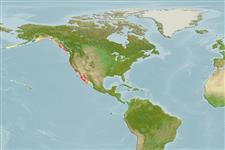Common names from other countries
>
Eupercaria/misc (Various families in series Eupercaria) >
Sciaenidae (Drums or croakers)
Etymology: Atractoscion: Greek, atraktos, arrow + Greek, skion, skiaina = barbel, red mullet (Ref. 45335).
More on author: Ayres.
Environment: milieu / climate zone / depth range / distribution range
Ecologia
marinhas demersal; intervalo de profundidade 0 - 122 m (Ref. 2850). Subtropical; 65°N - 22°N
Eastern Pacific: Alaska to southern Baja California, Mexico and the Gulf of California.
Tamanho / Peso / Idade
Maturity: Lm ? range ? - ? cm
Max length : 166 cm TL macho/indeterminado; (Ref. 40637); common length : 100.0 cm TL macho/indeterminado; (Ref. 9118); peso máx. Publicado: 41.0 kg (Ref. 2850); Idade máx. registada: 20 anos (Ref. 56049)
Descrição breve
Chaves de identificação | Morfologia | Morfometria
Espinhos dorsais (total) : 10 - 11; Raios dorsais moles (total) : 20 - 23; Espinhos anais: 2; Raios anais moles: 8 - 9; Vértebras: 24. Pelvic fins with fleshy appendage at base.
Often in schools over rocky bottom and in kelp beds (Ref. 2850). Also found in the surf zone (Ref. 2850). Young in bays and along sandy beaches (Ref. 2850). Feed on fishes, squids, and crayfish (Ref. 6885). Pelagic spawners (Ref. 56049). Excellent food fish (Ref. 9118).
Pelagic spawner (Ref. 56049).
Eschmeyer, W.N., E.S. Herald and H. Hammann, 1983. A field guide to Pacific coast fishes of North America. Boston (MA, USA): Houghton Mifflin Company. xii+336 p. (Ref. 2850)
Categoria na Lista Vermelha da IUCN (Ref. 130435)
CITES (Ref. 128078)
Not Evaluated
Ameaça para o homem
Harmless
Utilização humana
Pescarias: pouco comercial; peixe desportivo: sim
Ferramentas
Relatórios especiais
Descarregue XML
Fontes da internet
Estimates based on models
Preferred temperature (Ref.
115969): 9 - 22.9, mean 12.8 (based on 76 cells).
Phylogenetic diversity index (Ref.
82804): PD
50 = 0.5312 [Uniqueness, from 0.5 = low to 2.0 = high].
Bayesian length-weight: a=0.00794 (0.00404 - 0.01563), b=3.07 (2.91 - 3.23), in cm Total Length, based on LWR estimates for this species & (Sub)family-body (Ref.
93245).
Nível Trófico (Ref.
69278): 4.3 ±0.70 se; based on food items.
Resiliência (Ref.
120179): Baixo, tempo mínimo de duplicação da população 4,5 - 14 anos (K=0.13; tm=4; tmax=20).
Fishing Vulnerability (Ref.
59153): High to very high vulnerability (70 of 100).
Climate Vulnerability (Ref.
125649): Moderate to high vulnerability (48 of 100).
